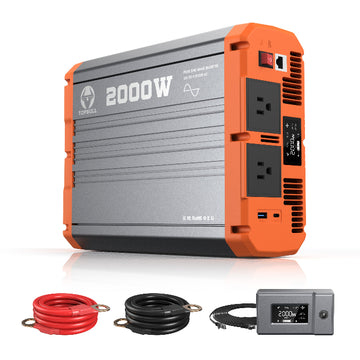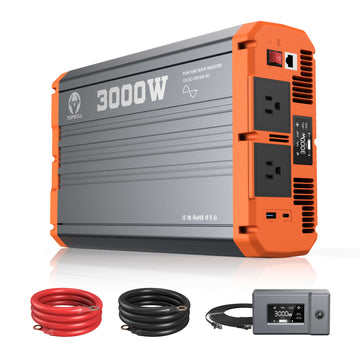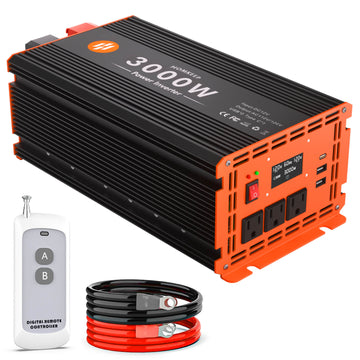Whether you're planning a camping trip or building a backup power source, 750W inverters are compact and powerful devices. But with so many devices and tools that require power, how do you know which ones a 750-watt inverter can run? What are the limitations?
This article will guide you through the details of a 750W inverter and help you maximize its performance.
What can a 750-watt inverter run?
The term “750W” refers to an inverter with a continuous output of 750W and a peak surge power of up to 1500W, which usually lasts for 3-5 seconds. In reality, the inverter loses energy in the form of heat during operation (usually 5-10%), and the actual power available is 675- 712W.
Devices with less than 750W of continuous power and less than 1500W of surge power can use a 750W inverter. Here is a list of some common devices:
- Lighting equipment: LED lights, energy-saving lamps
- Electronic equipment: laptop (50-100W), tablet (10-30W), cell phone charger (5-25W), etc., suitable for long-distance travel or outdoor office.
- Audio-visual equipment: LCD TVs under 32 inches (100-200W), projectors (200-300W), portable stereos (20-50W), etc.
These devices consume less power and have no starting current, so you can use more than one of them at the same time, but you must be careful not to exceed 700W in total power.
Some devices with surge power:
- Camping refrigerator:100-300W
- Small water pump:700 or less models
- Electric drill, angle grinder: 500-700W
When using the above equipment, the power may be doubled at startup, so avoid using multiple devices at the same time.
Limitations and precautions for 750W inverter
Although 750W inverters are capable of powering a wide range of equipment, their power capacity and design features dictate clear boundaries for use, and understanding these limitations is key to avoiding equipment damage or safety hazards.
Unable to support high-energy consumption appliances
The total power of the devices connected to the 700W inverter cannot exceed 700W, which may trigger the overload protection or cause the inverter to go down, even if they are used briefly. However, many users tend to ignore the total power of the load when connecting multiple devices.
More importantly, motorized equipment can generate inrush currents of 2-3 times the operating power at the moment of startup. 750W inverters only support 1500 watts of inrush power, and forcing equipment to exceed the inrush limit may cause the inverter to burn internal components due to the inrush of current.
Low compatibility of corrected sine wave inverters
Common inverters are pure sine wave inverters and modified sine wave inverters. Pure sine wave inverters have an output waveform close to the mains and can be used in all devices. The low-cost 750W inverters often use modified sine wave output, whose waveform distortion may cause abnormal operation or damage to sensitive electronic devices (high-end audio, laptops, and microwave ovens).
In addition, a modified sine wave is less efficient for motorized equipment and may add 10-20% extra power consumption, further compressing the available power space.
Battery system matching
The efficiency of a 750W inverter is highly dependent on battery capacity and voltage. Taking a 12V battery system as an example, driving a 750W load requires a continuous current output of about 62.5A. If a normal 100Ah car starter battery is used, it can only last for about 1 hour under full load (considering 80% discharge depth), and high current discharge will significantly shorten the battery life. Therefore, users need to invest in additional deep-cycle batteries (e.g., lithium batteries) or expand the battery pack, otherwise, the actual usage time will be much lower than expected.
Tips for maximizing inverter performance
Controlling load power
Take care to check the starting power and power rating of the device, which are usually labeled on the product casing. When using the 750W inverter daily, reserve at least 20% power redundancy to extend the life of the device and to cope with sudden load fluctuations.
When connecting multiple loads at the same time, pay attention to the staggered use of the device. By starting the devices sequentially at intervals of 10 seconds or more, you can avoid multiple device surges stacking above the 1500W limit.
Battery system optimization
Batteries are critical to the efficient operation of the inverter system. While ordinary car starter batteries only support 50% discharge depth, high-efficiency lithium batteries can be discharged to 90-98% and have a long cycle life of more than 2,000 cycles.
Replacing low resistance cables and terminals
Upgrading the connecting wires from 10 AWG to 8 AWG reduces the voltage loss of a 750W system from 0.5V to 0.3V over a distance of 3 m. Choosing gold-plated copper terminals instead of ordinary copper-aluminum hybrid connectors reduces contact resistance by 30% and reduces the risk of localized heating.
Routine maintenance
Regular maintenance and inspection of the inverter is conducive to prolonging its service life, and the inspection includes:
- Use a multimeter to check the no-load power consumption of the inverter every 3 months (it should be <10W); if it is abnormally high (e.g. >20W), the internal components may be aging and need to be overhauled.
- Clean the vent dust with compressed air every month to avoid the accumulation of dust leading to a 15-20% decrease in cooling efficiency.
Learn More: Power Inverter Repair & Maintenance
Upgrading your inverter
In addition to the above methods, choosing a quality pure sine wave inverter can greatly improve efficiency. The pure sine wave has a higher conversion efficiency than the modified sine wave. For example, to drive a 500W angle grinder, a pure sine wave inverter draws only 550W, whereas a modified sine wave may require 580W.
Topbull pure sine wave inverters have very low no-load and are built to last with high-quality components.
Shop now

How to choose the right 750W inverter
Among the many inverters on the market, choosing a truly reliable 750W inverter that fits your needs requires a multi-dimensional approach. The following core elements will help you avoid marketing traps and pinpoint the optimal solution:
Waveforms
The pure sine wave is friendly to sensitive appliances and has a higher conversion efficiency, but it is 30-50% more expensive than a modified sine wave. A Corrected Sine Wave, although less expensive, can cause sensitive equipment to operate abnormally (e.g., flickering screens, overheating motors). Determine if your load needs a pure sine wave inverter before making your choice.
Peak surge capacity
A quality 750W inverter should have a surge power of ≥1500W (sustained for 3-5 seconds) and be clearly labeled with the number of times supported (e.g., up to 20 times per day). Be wary of falsely labeled parameters - some cheap models surge only 1200W and are prone to overheat protection.
Efficiency certification
The efficiency of an inverter is very important. Inefficient inverters lead to wasted energy and more hidden costs. Efficient inverters typically consume <1W of standby power, while cheap inverters may be as high as 5-10W.
Heat dissipation system
The cooling system of the inverter is also crucial, it directly affects the stability, efficiency, and life of the equipment. In a high-temperature environment, for every 10°C reduction, the life of inverter components can be extended by 2 times, while poor thermal design may cause efficiency to plummet by more than 20%.
Hardware design
- Cooling system: Prefer models with fans (e.g. POTEK 750W), which are activated only at high temperatures to reduce dust inhalation. All-aluminum housing is 40% more efficient than plastic for heat dissipation and can extend capacitor life by more than 2 times.
- Port configuration: at least an AC outlet, USB, and Type-C.
- The inverter should have the standard seven protection functions: overload, short circuit, over temperature, low/high voltage cutoff, high temperature, and leakage reverse polarity protection.
FAQ
Q: Will a 750-watt inverter run a refrigerator?
A: It is possible to run camping-specific mini-fridges with peak power not exceeding 1,500 W. Commonly used fridges on the market have a start-up surge power (1,500-2,200 W) that exceeds the peak capacity of the 750 W inverter.
Q: Will a 750W inverter run a TV?
A: A 750-watt inverter can run some LED TVs (50-200 watts of power consumption), but you need to be careful about the startup current of the TVs and not run more than one device at a time.
Q: How many batteries do you need for a 750W inverter
A: How many batteries you need for a 750w inverter depends on the power required by the load and the runtime.












